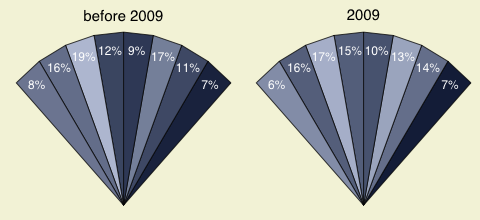If ballplayers could aim their hits with any consistency, perhaps we’d have seen a few more .400 hitters in baseball history. But, as we’ve learned through years of studying the game, it’s not that easy. Hitters have little reaction time between when the pitcher releases the ball and when the ball crosses the plate. During that time a batter must decide where the ball will cross the plate, the velocity of the pitch, the break of the pitch, and then finally of whether he will swing. And then it’s a matter of hitting a sphere with a cylinder. But you know all this, and you know it makes it difficult for a batter to aim his hit to a particular portion of the field.
A hitter can help his case, of course, by generally going with the pitch. Some hitters seem to do this better than others, and over the past 14 years we’ve had the pleasure of watching Derek Jeter slap outside pitches to right field. When pitchers try to work Jeter inside, he can turn around and pull a ball down the left field line, just to keep them honest. In fact, before 2009 he hit more ground balls and line drives down the left field line than the right.
Today at FanGraphs, Dave Allen examines Jeter’s hit tendencies, specifically ground balls and line drives — the batted ball types that generate the most hits. He uses the following field slices to describe where Jeter hits his ground balls and line drives. The number represents the percentage of all GB and LD hit to that field slice, and the shading represents slugging percentage on those hits, the lighter the lower.

Allen makes a few notations about the difference in 2009:
The worst places to hit a grounder are straight at the second basemen or shortstop, those are the grayest slices and in 2009 Jeter cut down the the percentage of his hits to those two slices by 4% (2B) and 2% (SS). He had more hits right up the middle (25% versus 21%), which are singles and doubles more often than outs.
Again, the improvement comes in Jeter’s bread and butter areas, up the middle and to right field. While Allen noted his up the middle increase, Jeter also increased the percentage of GB and LD he hit between the first and second baseman. This probably played a large part in Jeter’s high BABIP, .369.
Allen follows the above block quote with the following: “I don’t think this is a shift in true talent: I don’t think Jeter is any better at ‘aiming’ his grounders.” I’m not as sure. There isn’t a real way to prove this, so for now all we can do is guess. Jeter did, however, display a more discerning eye in 2009 than he had in the two previous years, increasing his pitches seen per plate appearance. Does a keen batting eye allow a player to better aim his hits?
To the average Yankees fan, with the heavy bias that comes with watching a single team so frequently, Jeter does seem better at aiming his hits than other hitters. In 2009 he seemed exceptional, often jumping on the first pitch of the game and depositing it in the shallow outfield. No, he can’t hit a baseball anywhere at will. But it does appear he embodies the Wee Willie Keeler mantra of “hit it where they ain’t.”
Leave a Reply
You must be logged in to post a comment.